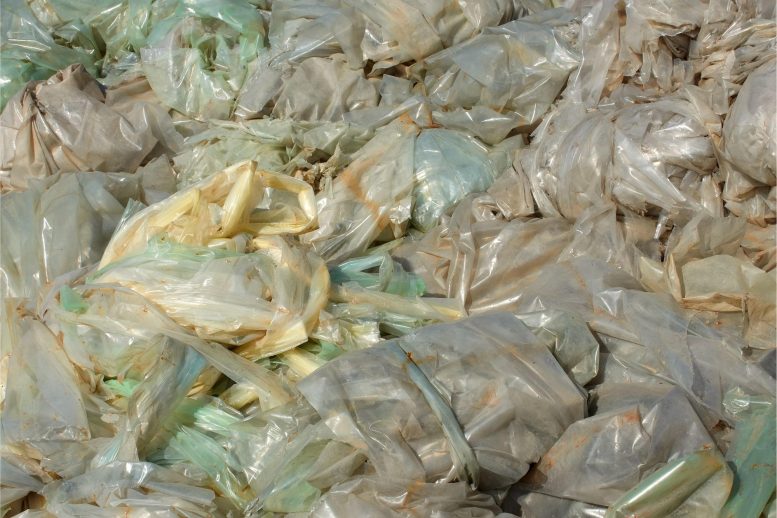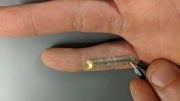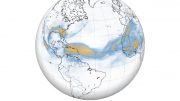
Researchers at the University of Adelaide have innovated a method to convert polyethylene waste into valuable chemicals using light-driven photocatalysis and solar energy, paving the way for sustainable waste management and contributing to a circular economy.
An international team of scientists undertaking fundamental research has discovered a method to use polyethylene waste (PE) as a raw material. They have successfully transformed it into valuable chemicals through a process called light-driven photocatalysis.
The University of Adelaide’s Professor Shizhang Qiao, Chair of Nanotechnology, and Director, of the Centre for Materials in Energy and Catalysis, at the School of Chemical Engineering, led the team that published their findings in the journal Science Advances.
“We have upcycled polyethylene plastic waste into ethylene and propionic acid with high selectivity using atomically dispersed metal catalysts,” said Professor Qiao.
“An oxidation-coupled room-temperature photocatalysis method was used to convert the waste into valuable products with high selectivity. Nearly 99 percent of the liquid product is propionic acid, alleviating the problems associated with complex products that then require separation. Renewable solar energy was used rather than industrial processes that consume fossil fuel and emit greenhouse gases. This waste-to-value strategy is primarily implemented with four components, including plastic waste, water, sunlight, and non-toxic photocatalysts that harness solar energy and boost the reaction. A typical photocatalyst is titanium dioxide with isolated palladium atoms on its surface.”
Addressing Plastic Waste Challenges
Most of the plastics used today end up being discarded and accumulated in landfills. PE is the most widely used plastic in the world. Daily food packaging, shopping bags, and reagent bottles are all made from PE. It is also the largest proportion of all plastic waste and primarily ends up in landfills, posing a threat to the global environment and ecology.
“Plastic waste is an untapped resource that can be recycled and processed into new plastics and other commercial products,” said Professor Qiao.
“Catalytic recycling of PE waste is still in early development and is practically challenging because of chemical inertness of polymers and side reactions arising from structural complexities of reactant molecules.”
Potential Impact and Future Applications
Current chemical recycling for PE waste is operated at high temperatures greater than 400 degrees centigrade that yield complex product compositions.
Ethylene is an important chemical feedstock that can be further processed into a variety of industrial and daily products, while propionic acid is also in high demand owing to its antiseptic and antibacterial properties.
The team’s work aims to address contemporary environmental and energy challenges, contributing to a circular economy. It will be of use in further scientific research, waste management, and chemical manufacturing.
“Our fundamental research provides a green and sustainable solution to simultaneously reduce plastic pollution and produce valuable chemicals from waste for a circular economy,” said Professor Qiao.
“It will inspire the rational design of high-performance photocatalysts for solar energy utilization and benefit the development of solar-driven waste upcycling technology.”
Reference: “Photocatalytic production of ethylene and propionic acid from plastic waste by titania-supported atomically dispersed Pd species” by Shuai Zhang, Bingquan Xia, Yang Qu, Liqiang Jing, Mietek Jaroniec, Jingrun Ran and Shi-Zhang Qiao, 8 December 2023, Science Advances.
DOI: 10.1126/sciadv.adk2407









So PE waste primarily ends up in landfills does it?
I guess all the massive plastic recyclers are just there for show. And not actually doing anything.. hmm?
Plastic film primarily ends up in landfills; but many, many countries don’t have the infrastructures, the money or other required resources to collect, transport,
sort, shred and remanufacture plastic.
Very informative. Thank you so much for making this information available!
This a fantastic move forward in our battle with PE plastics. It’s lab teams like this one, working on ways to fix our mess, that will end up saving the world. The human race is lucky to have you. Thankyou for your work.
Nothing moves forward without financial incentives and business models – the very scourge of why we have a recycling focus than a re-use focus. For example, when Malta first joined the EU, I was reliably informed that their time-honoured practice of recycling drinks containers was actively banned in favour of single-use recyclable containers.
I suspect that any advanced process that denies the recyclers will face overwhelming opposition from existing waste management enterprise, until such time that it becomes a more attractive business model.
Ecological concerns will always feature well below the financials, and a sad indictment of the changing planet we live upon.
It all starts with each individual being aware of how we treat trash. We can not leave it all to the experts or the authorities.
Nice lab exercise. Congrats! But in real life is never going to work. The reality is that for every 5 grams of PE, or less as in a bag, you will get a pound of dog poop, paper , food waste , dirt…..etc. so you better plan for a solid waste facility with a tiny plastics recovery , cute, system.